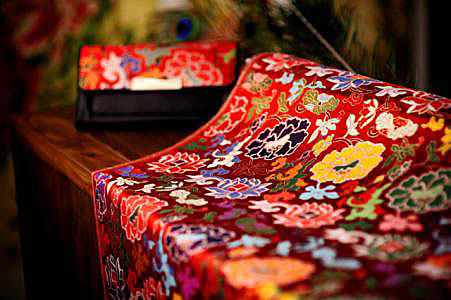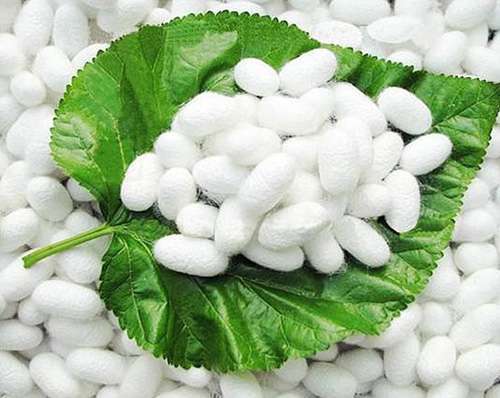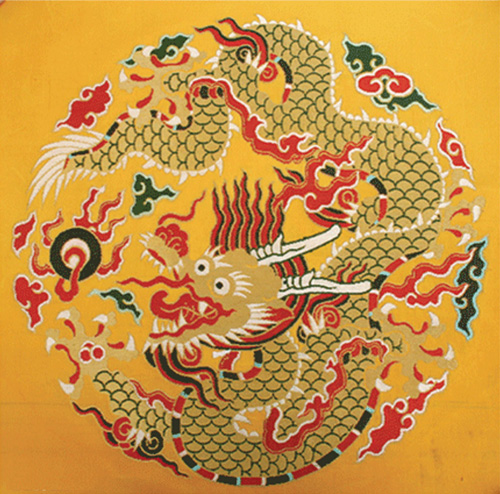China is the cradle of the world silk civilization. The ancient Chinese people began to plant mulberry, breed silkworm, and reel silks around 6,000 years ago, creating an early silk civilization and conceiving the rich Chinese silk culture. Silk also become an essential part of Chinese civilization. Since the 4th and 5th centuries, the gorgeous silk productions were spread to Asia, Europe, and Africa through the "Silk Road" and became one of China's symbols.

The earliest silk fabric ever found worldwide is the mulberry silk residues from the Wanggou site of Yangshao Culture (5300 B.C - 5500 B.C) in Puyang, Henan province, indicating that the Chinese ancestors already mastered the technique of silk making in Neolithic times. In the early dynasties of Shang and Zhou Dynasties, fractions of silk fabrics were also discovered. From these limited pieces of silk, the figured silk already appeared at that time. In the Zhou Dynasty, the silk producing techniques were further developed, and the silk road on grassland was pioneered. During the transition times of the Spring and Autumn Period and Warring States Period, the silk fabric making skills were bettered and reached a high level.
During the Qin and Han Dynasties, silk production was further advanced, and the areas of the middle and lower reaches of the Yellow River became the significant production base. After the Eastern Han Dynasty, the Shu Silk in southwest Sichuan became famous in China. After Emperor Wu of the Han Dynasty controlled the Hexi Corridor connecting the western world, he sent Zhang Qian to expedite western China and dredged the communications between east and west. Since then, the Chinese silk fabrics were exported to Middle Asia, Western Asia, and Europe. Along with the silk, silk production technology was brought to these places. In the late Eastern Han Dynasty, China fell into chaotic and divided situations, making it a time for silk development. At this time, northern China was still the main production area, and Sichuan silk was still very developed. In addition, the silk industry in southern China began to develop.
base. After the Eastern Han Dynasty, the Shu Silk in southwest Sichuan became famous in China. After Emperor Wu of the Han Dynasty controlled the Hexi Corridor connecting the western world, he sent Zhang Qian to expedite western China and dredged the communications between east and west. Since then, the Chinese silk fabrics were exported to Middle Asia, Western Asia, and Europe. Along with the silk, silk production technology was brought to these places. In the late Eastern Han Dynasty, China fell into chaotic and divided situations, making it a time for silk development. At this time, northern China was still the main production area, and Sichuan silk was still very developed. In addition, the silk industry in southern China began to develop.
The prosperous Sui and Tang Dynasty greatly promoted silk clothing development and brought the silk trade to a new level. The silk production was not limited to northern China and Sichuan anymore. Also, southeastern China in the lower reaches of the Yangtze River became one of the critical silk production bases. Besides, besides the Land Silk Road opened up in Han Dynasty, Maritime Silk Road was opened. Therefore, numerous silk productions were sailed to the Korean Peninsula, Japan, Southeast Asia, India, and the silk techniques were brought to these countries as well. Since the 7th century, silk manufacturing appeared in Japan, southeastern Asia, India, and even Europe.
In the Song Dynasty, China fell into a state of separation and division again. The silk production began to shift from north China to south China, but the former still held an important position in producing high-quality silk fabrics. In the Southern Song Dynasty, silk production became exclusive in south China, and Zhejiang became the "Home of Silk." Meanwhile, the state-run silk workshops began to scale, and the booming economy also boosted silk development. In terms of the silk trade, the Land Silk Road blockage drove the Maritime Silk Trade's drastic development. In the Yuan Dynasty, the silk economy was damaged, and the silk production in northern China declined, leaving south China the only base for silk production. The Yuan rulers set up many government-funded workshops to manufacture the silk fabrics on a large scale.
important position in producing high-quality silk fabrics. In the Southern Song Dynasty, silk production became exclusive in south China, and Zhejiang became the "Home of Silk." Meanwhile, the state-run silk workshops began to scale, and the booming economy also boosted silk development. In terms of the silk trade, the Land Silk Road blockage drove the Maritime Silk Trade's drastic development. In the Yuan Dynasty, the silk economy was damaged, and the silk production in northern China declined, leaving south China the only base for silk production. The Yuan rulers set up many government-funded workshops to manufacture the silk fabrics on a large scale.
In the Ming Dynasty, the silkworm breeding and silk production scale decreased, and south China became the silk center. There were five important silk towns, namely Suzhou, Hangzhou, Songjiang, Jiaxing, and Huzhou. There were also over 20 government-run weaving and dyeing factories. In the 16th century, the Portuguese opened up the direct trade between Europe and China. The maritime prohibition policy of the Ming court limited a lot of silk trade. In the middle and late Ming Dynasty, the policy loosened a little, and the Chinese raw silk and silk clothing were traded to Europe in a considerate size. In the Qing Dynasty, silk production was reduced, and the constant prohibition on maritime trade also greatly hindered silk export.
The raw material of silk came from the silkworm. Breeding silkworms is a lengthy process that requires excellent carefulness. The young silkworms must be fed with tender mulberry leaves, and these leaves must be continuously replaced. Around 28 days later, these silkworms will grow bigger enough to spin and cocoon. The cocoons are the raw materials for silk fabrics.

Step 1: Choose the best cocoons.
Step 2: Boil these cocoons at a high temperature.
Step 3: Reel the silk off the cocoons and wrap it onto spools.
Step 4: Spin these silk filaments into threads and weave into fabrics.
Chinese silk is not just gorgeous clothing; it's more like a symbol of China's splendid civilization. After thousands of years of development, a unique silk culture is formed.
Su embroidery is the first and the most famous one among the four famous embroideries in China. Originated in Suzhou, Su embroidery is praised as the "Oriental Pearl."
Shu Embroidery has a long history. It can be a small piece like a handkerchief or a big picture with various animal patterns; every Shu embroidery piece is a work of art.

It refers to the embroidery works produced in Hunan province. It's the first Chinese embroidery work that had won an international award.
Originated in Guangdong, Yue embroidery has a long history and became a unique branch in the middle and late Ming Dynasty. Besides, Yue embroidering workers were mostly men.
Rooted in Nanjing, the Yun brocade got its name from its cloud-like texture, gorgeous and glossy color. It was unusually famous in old times that it became the appointed materials for clothes of imperial families in the Yuan, Ming, and Qing dynasties.
Together with the Shu Embroidery, Shu brocade belonged to the specialties of Sichuan. It dominated the brocade world in Qin, Han, Sui, and Tang eras and was one of the most important traded commodities.
Based on the Tang era Shu brocade, the Song brocade appeared in the late Southern Song Dynasty in Suzhou. It is soft but firm in texture, abrasion-resistant, and can stand the repeated washing. Therefore, Song brocade has a wide range of applications.
1.Environmentally-friendly: silk is completely made out of silkworms, which is very environment-friendly.
2.Good for Human Skin: silk contains about 18 kinds of useful amino acids that can help human skin to maintain the metabolism of panniculus and keep skin moisturized and smoothed.
3.Glossy and comfortable: the silk fabrics are shinier and softer than any other materials.
4.Germproof: the silk can filter the poisonous air and prevent the ultraviolet ray.
5.Static electricity-free: the silk protein is a poor conductor that hardly creates static electricity.
The quality silk fabrics are soft, glossy, bright, smooth, cool, and even in color. While the rayon silk fabrics are too bright, gummy, board, and not cool.
Rub the silk fabrics with your hands and listen to the sound. If there is hiss sound, the fabric is the authentic silk fabric.

1. Hand washing is recommended, and the temperature should be around 35 degrees celsius.
2. Silk is not alkali-proof; therefore, the neutral detergent or special detergent for silk is recommended to use.
3. When washing the silk, the washing powder or suitable soap tablet should be dissolved into hot water first. Then, put the silk into the cooled water and soak for about 20 minutes. Remember to rub gently.
4. Hang the silk in a cool and ventilated place and make sure it's not exposed to the sun directly. Otherwise, the ultraviolet radiation in the light will embrittle and discolor the silk filament.
5. When the silk is 80% dry, cover the silk with a white cloth and iron it at a temperature around 100 degrees. Do not use steam or spray water. Otherwise, there will be water stains.
Tip 1: Make sure your silk clothes are thoroughly cleaned before storage. It's best if it can be dry cleaned so that the garment's texture and shape are better protected and the clothes are better sterilized.
Tip 2: When storing your silk clothing, make sure the white pieces are wrapped with bright blue paper to prevent them from yellowing, and the colored pieces are wrapped with dark colored paper to avoid the color fading.
Tip 3: Silk clothing is thin, light, and easy to wrinkle. It should be stored or placed separately or on the upper layer of the closet.
Tip 4: Velvet garments like pleuche must be hung up. Otherwise, the velvet will be deformed.
Tip 5: If the mildew emerged on the silk clothing due to the dampness, use a piece of flannel or new towel to wipe it gently. If the mildew is sizable, spray a little ammonia water on the spot and iron it to eliminate the mildew. If the white silk happens to have small mildews, a little alcohol will be very helpful.

If you are a fan of Chinese silk, this Silk Tour might be great for you. You can sign up for our 3-hour Chinese Silk Exploration Tour in Suzhou and Shanghai, during which you will know all kinds of silk fabrics and learn how to differeniate them and choose the best one for you.
If you want to experience the Silk Road and see what it was like to travel thousands of miles to the west, check out the handpick Silk Road Routes of Lilysun China Tours.
Copyright © 2019 Lily Sun China Tours International, Inc. Terms &conditions | Privacy Policy | Sitemap